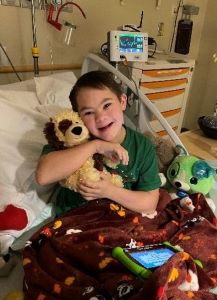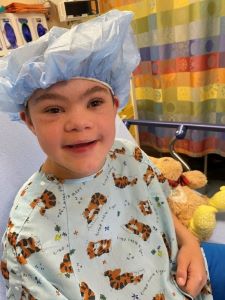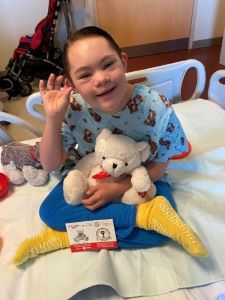
He answers to Regan as well as nicknames like Ray-Ray, Ray and even Oregano. After managing diabetes, kidney failure, thyroid disease and more, you could also call 15-year-old Regan and his family brave, inspiring and blessed.
Born with Down syndrome, Regan was diagnosed with Type 1 diabetes as an infant. Since then, he’s had diabetes-related kidney failure and other complications. With faith and fortitude, the family makes it work.
“Ray’s siblings are good with him,” said Regan’s mom Candace. “He adores them! He goes to his brother Brett for fun and entertainment and sister Carissa for motherly care when I’m busy. When Regan is hospitalized, everyone pitches in with meals, chores and support.”
Despite adult-sized burdens, Ray-Ray loves family, friends, music, sunshine and life.
A baby on the way and unexpected news
When Candace was pregnant with Regan, doctors said her baby had a one-in-three chance of having Down syndrome. This genetic condition can cause mild to severe physical, developmental and health problems.
“It was out of left field,” said Candace. “I had two healthy children. I was 30 years old with no family history of genetic disorders.”
After Regan was born, blood samples confirmed Down syndrome.
“Joy and sorrow are powerful emotions,” Candace said. “It’s hard to wrap your mind and heart around feeling both at once.”
“As time goes on, he’s just Regan, our beautiful, precious boy,” she added. “Ray brings joy to those around him. He’s loving, affectionate, funny, smart, moody and – at times – a mischievous little stinker! Down syndrome doesn’t define who he is; it’s simply a part of who he is.”
An infant’s healthy start takes some terrifying turns
Regan had no health concerns and met developmental milestones ahead of schedule. At 5 months old, everything changed when he began having seizures. Doctors referred him to Phoenix Children’s neurologist Saunder Bernes, MD, who diagnosed infantile spasms – a rare form of epilepsy. It can halt normal development if difficult-to-treat spasms aren’t controlled.
Dr. Bernes ultimately prescribed ACTH – a hormonal therapy that stimulates the brain to produce other hormones. The spasms stopped, and Regan got better.
“Dr. Bernes took excellent care of Regan,” Candace said. “This medication saved his life, but it’s hard on the body.”
Regan was well until he got strep throat, a painful bacterial infection. His condition worsened. Candace returned to the pediatrician they’d seen, but doctors weren’t concerned.
“By now, he was weak, emaciated and couldn’t hold down milk or water, yet was soaking his diapers,” said Candace.
Candace took Regan to a local emergency department. Lab work revealed insufficient insulin and extremely high blood sugar. Regan had diabetic ketoacidosis (DKA), a medical emergency that can cause diabetic coma and death.
A helicopter waited to fly Regan to the nearest hospital in Phoenix for a higher level of care. They said Regan was unlikely to survive and told Candace her family should say their goodbyes.
“I was shocked and confused,” Candace said. “We were terrified. In a crisis, I'm calm and do what I have to do. It’s after it’s all over that I fall apart.”
Once admitted to the pediatric intensive care unit (PICU), expert vigilance, monitors, and IV lines helped stabilize Regan’s sugar and insulin. His pancreas wasn’t making enough insulin hormone to get blood sugar into cells to produce energy, and his diabetes remained difficult to manage.
“It was erratic, even in the PICU,” Candace said. “His sugar goes up or crashes for no apparent reason.”
At age 3, Hashimoto’s, an autoimmune thyroid disease, added new challenges. Regan also has speech apraxia, a brain-pathway injury, making communication difficult at times.
Over his first five years, Regan had lifesaving interventions and saw different endocrinologists for his diabetes. Eventually, Regan came to Micah Olson, MD, at Phoenix Children’s.
“Dr. Olson has done an amazing job with Regan!” said Candace.
Regan’s continuous glucose monitor (CGM) displays real-time graphs and alarms on Candace’s phone app. They alert Candace to out-of-range numbers so she can give Regan insulin or make treatment decisions.
Diabetes-related nerve damage
When Regan was a toddler, Candace noticed he had kicked off his shoes and was running barefoot across hot pavement under the intense Arizona sun.
“I ran out to grab him,” said Candace. “He was burning his feet by walking on the pavement. Sometimes, his feet were bruised. He tires quickly, and his legs hurt all the time. I was sure he had neuropathy.”
Neuropathy (peripheral nerve damage) is a rare diabetic complication at such a young age. Symptoms include nerve pain and numbness. Doctors weren’t concerned, but Candace persisted.
She returned to Regan’s Phoenix Children’s neurologist, Dr. Bernes, who agreed to test for neuropathy. When the results confirmed Candace’s suspicions, he prescribed Gabapentin for nerve symptoms.
Diabetes-related kidney failure

At age 13, Regan’s endocrinologist prescribed medication when tests showed mild kidney damage — a common complication of diabetes. Medications helped protect Regan’s kidney function and manage any symptoms or complications.
A year later, Regan was referred to a nephrologist (kidney specialist). He saw German Lozano Guzman, MD, who evaluated Regan’s health and kidney function. On December 31, 2022, Regan had a renal biopsy to check for signs of kidney damage or disease.
Two days later, Regan awoke with fever, chills and vomiting. Regan was hospitalized in Phoenix Children’s endocrine unit and treated for infection.
“He felt terrible, but nurses tried to make him comfortable until he felt like himself again,” recalled Candace.
After additional hospitalizations and treatments, Regan’s symptoms and health didn’t improve. Within three months, his kidney function had dropped from 60-70% to around 17%. Dr. Lozano Guzman informed the family that Regan’s kidneys were failing, and he needed to begin dialysis therapy.
In March 2023, Katherine Perry, MD, chief of Nephrology at Phoenix Children’s, started Regan on hemodialysis (HD). HD removes fluids and waste and performs other essential kidney functions. He did well at first, but he had recurring HD-line bacterial infections.
“Within a few months, he already had five different HD lines,” said Candace.
Regan’s nephrologists decided to try peritoneal dialysis (PD) – a home-based abdominal blood-filtering procedure. It’s not ideal for Regan since it uses dextrose (sugar), but Regan gets additional long-acting insulin at night and dialysis while he sleeps. After preparatory surgery in August, Regan started PD in October 2023.
“Setting up the machine, changing dressings and unhooking his line takes time, but it’s nice doing that at home,” Candace noted.
In tune with people, emotions and melodies
Candace homeschools Regan. He also attends the nearby church micro-school when he can, and his favorite class is music.
“They love him and treat him well,” said Candace. “He has perfect pitch,” she said. “When playing piano or xylophone, he imitates what others play or songs he’s heard.”
“He can blow on the top of a water bottle and tell you what piano note that is,” she added. “After he takes a drink, the sound changes. He thinks that’s hilarious! He’s also sensitive to emotions and when people need hugs or attention.”
Another helicopter on the horizon – this time with a brighter outlook

In February 2024, the family traveled to the M Health Fairview University of Minnesota Masonic Children’s Hospital in Minneapolis — the nation’s only center specializing in combined pediatric kidney-pancreas transplantation. Multispecialty teams evaluated Regan and his family.
“I’m glad my husband was with me,” said Candace. “He sees different angles and thinks of questions I might miss. It’s hopeful, exciting and scary. A transplant would be life-changing!”
Regan was cleared for surgery and put on an active national organ donor list. They’re ready to go at any hour. Air ambulances are on standby, too.
“They’d prefer arrival within four hours,” said Candace. “Organs should be transplanted within 24 hours. Earlier transplantation improves outcomes.”
At Phoenix Children’s, Regan’s multispecialty teams will continue post-transplant care, collaborating with the Minneapolis teams.
“We’ve met amazing people, and we’re grateful,” Candace exclaimed. “Regan loves his doctors and nurses, and they love him back. They’re true-life heroes!”
Learn more about kidney care, dialysis and diabetes care at Phoenix Children’s.
